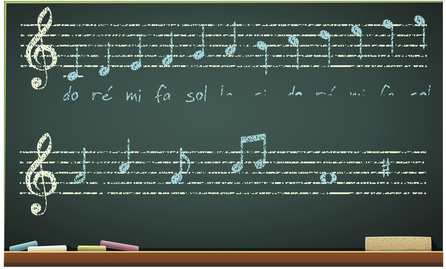Today I’m going to show you another great solfege exercise based on the major scale. This time we are going to focus on the notes within a major chord. Do-Mi-Sol.
This is part 2 in a 4 part series. So in case you missed it, here is part 1- Solfege: A Beginner’s Guide
Solfege Exercises
In part 1 of this series, we practiced moving within the solfege scale in stepwise motion. Stepwise motion = moving from any pitch in the scale to either of its neighbors. For instance Do-Re-Mi-Re-Mi-Fa-Mi-Fa-Sol-La-Sol etc.. These intervals are small (1/2 and whole steps) and relatively easy to hear.
Larger intervals can be more difficult to hear and execute. The distance between Do-Mi is a major third, which is equal to 3 half steps. The distance between Mi-Sol is a minor third (slightly smaller), which is equal to 2 half steps.
A great way to get this pattern in your ear is to sing it in all twelve keys. (I take you through all twelve keys at the beginning of the video.) Here is the pattern written out in the key of C.
C-E-G-E-C.

Next, try adding in Do-Mi-Sol as you move around the scale in stepwise motion. For example Do-Re-Mi-Do-Mi-Sol-La-Ti-La-Sol-Mi-Do.
Not hearing it? Don’t worry, this will take a little practice. Play the notes that you are having trouble hearing on the piano or virtual keyboard. Practice in the key of C to keep things simple. I’ll show you how here- Learn How To Sing And Play The Major Scale
What Are Benefits of Ear Training With Solfege Exercises?
Actively working on your pitch will elevate your artistry as a singer. Even when something is just a little bit out of tune, most listeners can feel that something isn’t right. When you have control over the technical aspects of your voice (pitch, breathing, tone, rhythm), you can become a much more effective emoter and communicator. Telling a story and expressing yourself, moving people with your voice; these things are much easier to do when you are singing beautifully in tune.
Enjoy your practice and stay tuned for part 3!







2 Comments
Brian Borin
January 29, 2016Hi! I found your website as I was looking for exercises to do with my elementary music classes. Just wanted to let you know that I spotted something you’ll want to correct: There are 4 half steps in a major third and 3 in a minor third, not 3 and 2 half steps as the paragraph indicates. Nicely done video!
Meghan Nixon
February 10, 2016Awesome! I hope this video was helpful. I do these exercises with my young students all the time. It improves their ears really quickly.
Leave A Response To Meghan Nixon Cancel reply